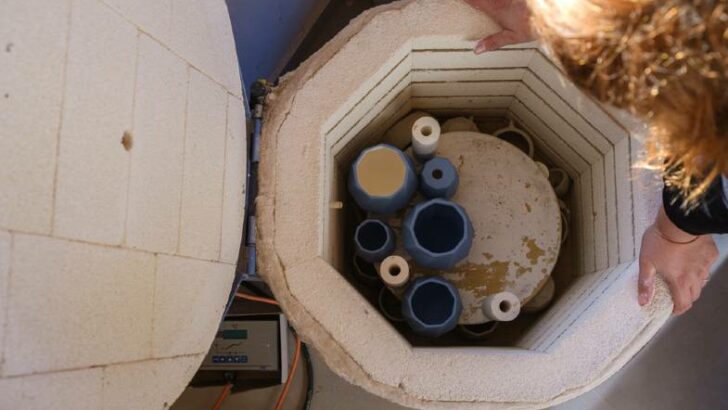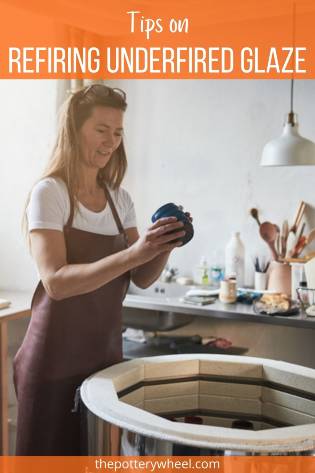Your cart is currently empty!
Can you Refire Underfired Glaze? – Rescuing Your Pots
Published:
Last Updated:

Affiliate Disclaimer
As an affiliate, we may earn a commission from qualifying purchases. We get commissions for purchases made through links on this website from Amazon and other third parties.
A lot of heart and soul can go into making your pottery. So, it can be gutting when your glaze doesn’t turn out how you wanted it to. If your glaze is underfired, you might be wondering if you can do anything to salvage your work. The question is, can you refire underfired glaze to rescue your ware?
You can refire underfired pottery glaze. How successful the results of refiring the glaze is will depend upon why the glaze was underfired. Sometimes refiring underfired glaze can work well. Other times it may not turn out as you would have liked. But it’s worth a shot.
During the glaze firing the glaze undergoes a lot of changes. And if that process is interrupted at any point in the firing schedule, you may end up with an underfired glaze. Exactly what the underfired glaze looks like depends on the temperature it was fired up to.

Spotting Underfired Glaze
Underfired glaze has not been fired to maturity. Its appearance will depend upon how underfired it is.
Matte Appearance
One of the key ingredients of glaze is silica, which is a glass-forming material. When the glaze gets hot enough in the kiln it melts.
If a glaze does not reach its target temperature and melt it will be underfired and look matte. It may look a little drier and harder than it did when it went in the kiln. But very underfired glaze, will not be glossy or glassy because the glass-forming stage didn’t get underway.
Orange Peel or Cloudy Appearance
However, when glaze gets hot enough to melt, gases and bubbles from the glaze will percolate out through the glaze. Also, any residual gases from the clay will be emitted through the glaze too.
If glaze is in its melted fluid state for long enough the bubbles pass through and the surface smooths out. If the firing schedule ends too soon, the bubbles don’t have enough time to be properly expelled from the glaze. As a result, they can be trapped in the glaze and cause a range of blemishes on your glaze surface.
So, glaze that is a little underfired didn’t quite reach its target temperature. As a result, the glaze may have melted but not had time to smooth out. This glaze can be pitted and have an orange peel texture. Or it might be cloudy with trapped bubbles.
Crazing
Sometimes underfired glaze can be crazed. The reason for this is that when glaze melts, the surface of the glaze mixes in with the surface of the clay. The glaze and the clay mingle with each other and form a bonded interface.
If the pottery is underfired, this matrix between the glaze and clay doesn’t form. And the glaze sits on top of the clay, like a badly fitting jacket.
Crazing can be a problem with glazes for different reasons. But if it’s due to underfiring, it’s often linked to the glaze chemistry. If the glaze doesn’t contain enough silica, it may not melt enough. And this can prevent the glaze from melting enough and bonding with the clay body.
If you have made your own glaze, then you can tweak the ingredients in your glaze mix. However, if you have bought commercially made glaze, changing the glaze chemistry is not really possible. It might just be that this glaze does not get on well with the clay you are using. A solution might be to simply experiment with other clay and glaze combinations to find one that fits.
Refiring Underfired Glaze
If glaze is underfired, refiring it can give the pottery a chance to mature. Often this process will be fine and your glaze will look as you would have hoped. But there are some things to look out for too.
Very Underfired Glaze
Sometimes mistakes are made when pottery is fired. For example, a stoneware glaze that needs to be fired to cone 6 might be put in an earthenware firing. When you take the pottery out of the kiln, you might find that the cone 6 glaze has simply not melted.
If you refire the underfired glaze at cone 6, the glaze will most likely mature in the second glaze fire. Earthenware temperatures are similar to bisque firing temperatures. So, in effect, the underfired pot has just been bisque fired twice. And firing to bisque temperatures more than once is normally fine.
Firing the pot again at cone 6 temperatures just means that the glaze gets hot enough to melt this time.
But what happens if your glaze starts to melt and form glass, but doesn’t quite mature when it’s fired. Firing it again is like glaze firing it for the first time.
Slightly Underfired Glaze
If your glaze has not quite reached the target temperature it will not be fully mature. However, glaze that is just a little underfired will have gone through chemical changes.
As a result, you may get some unexpected results. This is not necessarily a bad thing, and you may still get some nice results and effects. But, it’s as well to be aware of some of the things that might happen.
What Happens if You Refire Underfired Glaze?
How glaze responds if you refire underfired pottery depends upon the kind of glaze you are using. Glaze that is just a little underfired, has already had a lot of heatwork.
Heatwork is a combination of the temperature reached and the amount of time the glaze has been heated. It is heatwork that brings about the chemical changes in glaze. Once it has had a certain amount of heatwork, the chemical makeup of the glaze will have been altered.
So, when you are refiring, you are piling a lot of heatwork onto glaze that is already almost mature. This can lead to the glaze being over mature or overfired.
This can affect the glaze in the following ways:
Unexpected Color Changes:
When you refire underfired pottery, you can get some unexpected glaze colors. Glazes that you hoped would be red might turn brown. Some reds might turn green. Purples might turn khaki. And dark blues might become pale.
The colors that you get when you refire underfired pottery might be nice. But on the whole, they will be more organic looking. And can have a tendency to look a bit burnt out, which in effect they are.
If you can put aside your expectations and disappointment, some of these colors can actually be rather nice. They may just not be exactly what you had imagined when you were originally glazing your piece. At other times, they can simply be muddy and uninteresting.
Running Glaze:
Another thing that can happen if you refire underfired glaze is that the glaze can become quite runny. If your glaze is only a little underfired it will have had quite a bit of heatwork already.
As a result, the glaze can become thin, and slide down the piece, pooling at the bottom. Sometimes this results in drips. Other times it simply makes the glaze look a bit see-through.
The Good News
Sometimes when you refire underfired glaze, the glaze will mature and imperfections will smooth out. Most often when potters refire their glaze, they do it with an attitude of ‘what do I have to lose’.
If you approach refiring your ware with that attitude, then anything that works out well will be a bonus.
Some Tips for Refiring Underfired Glaze:
- If your pottery is significantly underfired, you can fire to the original target temperature.
- However, if your glaze is almost but not quite mature, then refire to a lower target temperature. For example, if your original target temperature was cone 6, you may have success refiring to cone 5.
- Alternatively, refiring a cone 5/6 glaze to bisque temperatures of cone 06 or 04 may be enough to even out any blemishes.
- Use kiln cookies if you refire pots. Kiln cookies are thin patties of clay that sit under your pots in the kiln. They act like coasters. So that if the glaze does run, it drips onto the cookie rather than your kiln shelf.
How to Avoid Underfired Glaze in the Future
Because refiring underfired glaze can be hit-and-miss, it’s best to get the firing right the first time around. There are a few reasons why glaze might be underfired. Here are some of them:
- An element in the kiln is not working well or has stopped working altogether. This can lower the overall temperature of the kiln, or lead to cool spots in the kiln.
- You may program your kiln incorrectly. Digital kiln controllers are easy to program. But they are also easy to make mistakes with. It’s always a good idea to check and double-check the selected program before you switch the kiln on.
- Kilns vary in efficiency. Some kilns heat up quickly, others take time. When you’re learning to use your kiln, it can take time to figure out what firing schedule suits your kiln. This is especially true when you buy a used kiln.
- Used kilns normally have quite a few miles on the clock, and are often a bit slower and less efficient. As a result, you will probably have to experiment with firing schedules to reach the cone you want.
Whilst you are testing out your kiln, you might find that some pottery is over-fired or underfired. Eventually, you will find that sweet spot where your pots are getting the right amount of heatwork. But whilst you are getting to know your kiln, you might produce some underfired glazes.
- Even if you have a kiln with a digital controller, it’s wise to use pyrometric cones in each firing. Cones will give you an accurate picture of what heatwork has been done in the kiln as it fired. If you want to know more about how to use pyrometric cones, check out this article.
Final Thoughts
If your glaze is underfired, then you don’t have much to lose by refiring your work. With time I have got more of an idea of which pots are worth refiring and which are not. Sometimes, if a piece doesn’t work out as you hope, it’s best to move onto something new. Refiring can make a bad glaze worse. Nevertheless, at other times, you can refire underfired pots and produce something unexpectedly lovely. I guess that’s why potters talk about the ‘kiln gods’!



